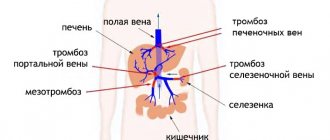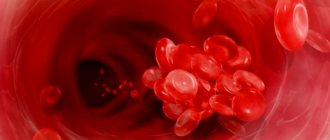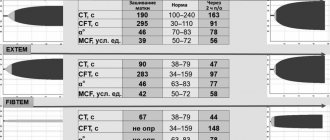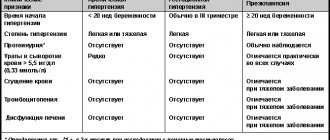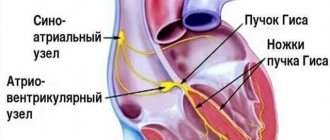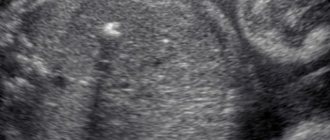Iron in the blood: general information
All inorganic substances in the human body are divided into macro- and microelements.
The former include calcium, sodium, potassium and magnesium. The prefix “macro” indicates a relatively large content of these elements in the body. Important!
Iron is not produced in the body and comes only from food. The most iron is found in red meat, mushrooms, cocoa, legumes, and some vegetables and fruits.
Iron is a micronutrient. But despite its small amount, this element plays a vital role in maintaining the vital functions of the body. Lack or excess of iron negatively affects health, which is expressed by a number of symptoms and diseases.
The main functions of iron include:
- Oxygen transport. Iron is a component of the hemoglobin pigment found in red blood cells (erythrocytes)1. Thanks to iron, hemoglobin is able to carry oxygen from the alveoli of the lungs to other organs and tissues.
- Hematopoiesis. In the bone marrow, iron takes part in hematopoiesis - the formation of blood cells, in particular, red blood cells.
- Detoxification of the body. Iron is part of a number of liver enzymes that take part in the destruction of toxic substances.
- Immunity. The level of leukocytes, as well as their activity, also depends on the level of iron.
- Cell division. Iron is part of the enzymes involved in DNA synthesis, a process necessary for normal cell division.
- Hormone synthesis. With the participation of iron, the synthesis of thyroid hormones occurs.
Iron contained in the human body comes in several types:
- Functional. This is iron, which is directly involved in many life processes. For example, iron contained in hemoglobin ensures the transport of oxygen from the lungs to each cell. In addition, this trace element is contained in myoglobin and some vital enzymes.
- Transport. This is iron that circulates in the blood. Note that there is no free iron in the blood (since it is toxic to tissues). Iron is transported in combination with carrier proteins. These are transferrin, lactoferrin and mobileferrin1.
- Deposited. The human body also has some iron reserves. Iron is mainly stored in the liver and spleen in the form of ferritin. It is a complex water-soluble protein complex. To a lesser extent, iron is deposited in the form of another protein - hemosiderin, which is formed during the destruction of hemoglobin.
- Free. Iron is found in this form inside cells. Due to its toxicity, free iron does not move inside the cell independently, but with the help of the protein mobilferrin.
About 75% of all iron in the human body is heme. It is found in hemoglobin, myoglobin and some enzymes. The rest, non-heme iron, is enclosed in transport and storage proteins.
The functions of iron in the body and signs of its deficiency. Image: MedPortal.
criteria for an excess of a substance in the body?
In such a situation, we recommend that you contact specialists who treat metabolic dysfunctions. A medical professional will help you find the causes, develop a personal research and treatment plan, and establish strict monitoring of your health.
Methods for treating excess iron :
- compliance with dietary nutrition,
- refusal of alcoholic drinks,
- use of antioxidants.
You should always remember that iron is not removed from the body, but remains in it for life!
This is why it is so important to detect this in the early stages and prevent the spread of dangerous substances to stop the functioning of the liver and many other organs, forming liver cancer, which will help you extend the years of your life.
Test for iron in the blood (Fe, Iron)
The level of iron in the blood is determined as part of a biochemical blood test. The unit used for this is micromoles per liter (µmol/l). For this purpose, venous or capillary blood is analyzed. The research method is photometric.
The simplest and most accessible way to assess iron content in the body is a clinical blood test, which is taken from a finger. In this case, you can estimate the hemoglobin level in grams per liter.
Refining the analysis
A hemoglobin blood test is an important but not sufficient procedure for assessing iron levels in the blood.
It happens that hemoglobin is normal, but iron levels are low. In this case, it is necessary to analyze additional parameters that will indicate the true content of the trace element in the body. It is noteworthy that the amount of serum iron is an indicator that varies depending on the day and even time of day. To minimize inaccuracies, determining the level of iron in the blood is usually combined with other tests. Among these are an analysis of total serum iron-binding capacity (TIBC), as well as tests for ferritin and transferrin. The indicators of THC and transferrin are used to determine the amount of iron that is currently transported in the blood.
Indications
The level of iron in the blood is determined for the following purposes:
- for diagnosis, differential diagnosis and control of treatment of various types of anemia;
- for diagnosing hemochromatosis, a hereditary disease in which iron metabolism is disrupted (there is too much of it);
- to determine transferrin saturation with iron (find out exactly how much iron the blood carries);
- to monitor the effectiveness of treatment with iron preparations.
The study is carried out if the following diseases and conditions are suspected:
- if there are deviations in the results of the general analysis (hemoglobin level, red blood cells, hematocrit);
- in case of poisoning with salts or drugs (overdose) of iron;
- if iron deficiency is suspected;
- for diseases of the gastrointestinal tract leading to impaired absorption of iron in the small intestine;
- with malnutrition (when the diet lacks iron, and this leads to adverse consequences);
- if you suspect hereditary pathologies accompanied by impaired iron metabolism;
- for various types of bleeding that can lead to the loss of a significant amount of iron (for example, heavy bleeding during menstruation, stomach ulcers and other conditions and diseases).
References
- Federal clinical guidelines for the diagnosis and treatment of iron deficiency anemia, 2015. - 58 p.
- Lukina, E.A., Smetanina, N.S., Tsvetaeva, N.V. and others. Iron overload: diagnosis and treatment. National clinical guidelines, 2021. - 14 p.
- Rumyantsev, A.G., Maschan, A.A., Chernov, V.M. Federal clinical guidelines for the diagnosis and treatment of iron deficiency anemia, 2015. - 43 p.
- Zaiko, N.N., Byts, Yu.V. Pathological physiology. M.: Medpress, 2008. - 640 p.
- Ganz, T., Nemeth, E. Iron metabolism: interactions with normal and disordered erythropoiesis. Cold Spring Harb Perspect Med., 2012. - Vol. 2(5).
- Chaparro, C., Suchdev, P. Anemia epidemiology, pathophysiology, and etiology in low- and middle-income countries. Ann NY Acad Sci., 2021. - Vol. 1450(1). — P. 15-31.
Preparing for analysis
Laboratory blood tests often require some preparation to obtain correct results. An analysis of iron levels in the blood (Fe, Iron) is no exception. As a rule, these are the following requirements (which doctors and diagnostic laboratory staff will definitely inform the person about):
- Blood must be donated on an empty stomach.
- 12 hours before the expected test, you should avoid eating fatty foods, smoking and drinking alcohol. Strenuous physical activity is also not recommended.
- If you have to conduct instrumental studies, then you need to donate blood before performing an X-ray or computed tomography.
- A week before donating blood, you should stop taking iron-containing medications. It is also recommended to discontinue other medications (if possible). If the medication cannot be delayed, the patient should tell the doctor, who will take this into account when interpreting the test results.
- If a person has had a blood transfusion, an iron test can only be done a few days after the blood transfusion.
There may also be other recommendations and restrictions for each patient. The doctor will definitely indicate them. It is important to strictly follow the prescribed rules, since the results of the analysis (and therefore the treatment regimen) depend on this.
During pregnancy, women often experience iron deficiency in the body. Photo: freeograph / freepik.com
How to increase low hemoglobin
Even a slight decrease in hemoglobin levels requires treatment. Otherwise, the man’s well-being will progressively deteriorate. Therefore, from the moment a general blood test is performed and low hemoglobin levels are established, it is necessary to make adjustments to the daily diet and start taking iron-containing medications. It is impossible to cope with the problem only by changing the diet and increasing the amount of iron sources in the body, since at best, as much of this trace element is absorbed from food per day as is consumed. This will not allow the formation of the necessary depots and eliminate the risk of re-development of anemia in the near future.
It is imperative that in combination with the treatment of anemia, therapy for the disease that provoked its development is prescribed. Accordingly, it will be strictly specific in each individual case.
Nutrition correction
With low hemoglobin, men are advised to increase the amount of iron-rich foods in the daily menu, as well as those containing folic acid, vitamin B12 and ascorbic acid, as they increase the quality of its absorption. These include:
- beef tongue, liver;
- white chicken, turkey, veal;
- various seafood, as well as red and black caviar;
- buckwheat, rice;
- leafy greens, cabbage, broccoli, green beans, spinach;
- legumes;
- pumpkin, tomatoes, beets;
- berries, especially black currants, blueberries, cranberries;
- fruits, in particular pomegranate, persimmon, dried apricots;
- peanut.
But when drawing up a menu, it is worth taking into account the peculiarities of iron absorption. So, you should not combine meat dishes with pasta, bread and cereals. They are recommended to be consumed with vegetable side dishes. It is also necessary to consume fermented milk products and nuts separately from other meals.
Normal blood iron levels for men, women and children
The normal level of iron in the blood is the amount at which the body functions fully. This indicator depends on a number of factors, including age and gender. Therefore, normal iron levels differ between children, women and men.
Iron levels during pregnancy
Separately, it is necessary to say about the norms of iron in the blood during pregnancy.
This period in a woman’s life is accompanied by serious changes not only in hormonal levels, but also in biochemical blood parameters, including iron. During pregnancy, the need for iron (as well as other macro- and microelements) increases. This is mainly due to the fetal needs for these substances. In addition, a pregnant woman's blood volume increases by about 30%. This means that the need for hemoglobin components (iron and amino acids) also increases.
It is worth considering that as the fetus grows, the physiological daily consumption of iron will increase. So, if in the first trimester the additional need for iron is estimated at 0.8 mg per day, then in the second trimester it is 5 mg, and in the third – up to 6-7 mg. During pregnancy, on average, a woman needs an additional 800-900 mg of iron.
Normal serum iron levels for a pregnant woman are 13-30 µmol per liter.
From the point of view of the body's supply of iron, the most vulnerable categories are considered to be pregnant women, as well as children and adolescents during the period of active growth and development.
Iron levels are also affected by physical activity, so people involved in sports also need to monitor this indicator. Table 1 shows the reference (normal) values of serum iron in the blood in micromoles per liter in women and men of different age groups. Table 1. Norm of iron content (µmol/l) in children of different ages, women and men
| Age | Floor | Iron norm µmol/l |
| less than 1 month | female | 5,1 – 22,6 |
| male | 5,6 – 19,9 | |
| from 1 to 12 months | female | 4,6 – 22,5 |
| male | 4,9 – 19,6 | |
| from 1 to 4 years | female | 4,6 – 18,2 |
| male | 5,1 – 16,2 | |
| from 4 to 7 years | female | 5,0 – 16,8 |
| male | 4,6 – 20,5 | |
| from 7 to 10 years | female | 5,5 – 18,7 |
| male | 4,9 – 17,3 | |
| from 10 to 13 years | female | 5,8 – 18,7 |
| male | 5,0 – 20,0 | |
| from 13 to 16 years old | female | 5,5 – 19,5 |
| male | 4,8 – 19,8 | |
| from 16 to 18 years old | female | 5,8 – 18,3 |
| male | 4,9 – 24,8 | |
| over 18 years old | female | 6,6 – 26 |
| male | 11,6 – 28 |
Complexes with this research
Entry into IVF Examination when a woman enters the IVF procedure 23,020 RUR Composition
Causes of hair loss 2,500 RUR Composition
Examination during pregnancy. 1st trimester 16,690 RUR Composition
IN OTHER COMPLEXES
- Biochemistry of blood. 19 indicators 6,280 R
- Women's check-up No. 1 RUB 19,290
- Pregnancy planning. Clinical indicators 6,630 R
- Examination during pregnancy. 3rd trimester 9,620 RUR
- Biochemistry of blood. 8 indicators 990 R
Causes of high iron
An increased level of iron is said to be when its concentration is more than 28-30 µmol/l (reference values may differ slightly in different laboratories).
The following diseases and conditions can be the causes of elevated iron levels in the blood:
- Hemochromatosis. This is a hereditary disease in which the rate of iron accumulation exceeds the rate of its removal from the body2. Due to such disorders, iron accumulates in tissues, which leads to a number of other diseases. For example, against the background of hemochromatosis, joints may become inflamed (arthritis), sugar levels may rise, and even cirrhosis of the liver may develop.
- Some types of anemia. If with iron deficiency anemia there is a lack of iron, then with hemolytic or sideroblastic anemia there is an excess. In hemolytic anemia, red blood cells are intensively destroyed. This results in the release of heme iron into the blood. With sideroblastic anemia, iron metabolism in the bone marrow is disrupted, which causes hemoglobin synthesis to slow down.
- Iron poisoning. Most often, such poisoning occurs due to an overdose of iron supplements. To prevent this problem, you should take such medications only as prescribed by your doctor. Keep them away from children. For them, the toxic dose is much lower than for adults.
- Thalassemia. This is a hereditary disease in which the process of hemoglobin synthesis is disrupted. With thalassemia, less iron is used for the formation of hemoglobin, which leads to its excess in the blood.
- Blood transfusion. Several days after a blood transfusion, a person usually has an increased iron content.
- Premenstrual period. In women, serum iron levels increase slightly before menstruation. This is a normal physiological phenomenon that can mislead the doctor if you donate blood for analysis during this period. For this reason, women are recommended to donate blood after menstruation.
- Some diseases of internal organs. The level of iron in the blood is greatly influenced by the condition of the liver, spleen and pancreas. With diseases of these organs, there may also be a disturbance in iron metabolism, leading to its excessive accumulation in tissues.
- Excessive iron intake. This is most often observed when taking iron supplements. An excess of iron in the blood from food is unlikely.
What symptoms indicate high iron levels?
Elevated levels of iron in the blood can be manifested by the following symptoms:
- nausea and vomiting;
- bowel disorder (diarrhea or constipation);
- renal dysfunction;
- unexplained weight loss;
- loss of appetite;
- pain and swelling in the joints;
- joint inflammation (arthritis);
- elevated blood sugar levels;
- atherosclerosis;
- hair loss;
- muscle pain;
- decreased immunity (resulting in frequent infectious diseases);
- decreased sex drive;
- delayed physical and mental development in children.
If iron levels are elevated, blood donation is recommended. Photo: kasto / Depositphotos
Causes of low iron levels
Low iron levels may result from the following diseases and conditions:
- Insufficient intake of microelements from food. This is the most common cause of serum and heme iron deficiency. Passion for diets, as well as refusal to consume animal proteins (vegetarianism, veganism) only aggravate this problem.
- Increased iron consumption. This is most often observed in children during periods of active growth and development, as well as during pregnancy and breastfeeding.
- Infectious diseases. Acute or chronic infections often lead to a decrease in serum iron. This mechanism is evolutionary, since with a low iron content in tissues, cell division (including bacteria) slows down.
- Vitamin deficiency. B vitamins, vitamin C and folic acid are necessary for normal absorption of iron in the intestines. A deficiency of these vitamins leads to poor absorption of iron.
- Anorexia and starvation. A pathological desire to lose weight can lead to anorexia. A person refuses to eat, which quickly leads to exhaustion of the body.
- Dysgesia and parosmia. Distortion of smell (parosmia) and taste (dysgesia) is one of the possible reasons for refusing foods containing iron. For example, a person may become disgusted with meat and meat products. This problem is especially relevant during the coronavirus pandemic. One of the complications of infection is impaired sense of smell and taste.
- Diseases of the digestive tract. Such pathologies impair the absorption of iron in the small intestine.
- Worms. Parasites feed on the host's nutrients and minerals. And some types of worms (for example, roundworms) also drink blood, which also leads to loss of hemoglobin and serum iron.
- Pregnancy and breastfeeding. Particular attention should be paid to the third trimester of pregnancy, when the additional consumption of iron is maximum. It should also be taken into account that the child receives iron through mother’s milk. Therefore, during lactation you also need to take care of getting an adequate amount of iron from food and/or medications.
- Substances that slow down the absorption of iron. These include calcium, vitamin E, zinc and oxalates. Iron absorption is also impaired by coffee and tea.
- Intoxication. Donating blood for iron is also not recommended immediately after infectious and inflammatory diseases. This is due to the fact that during intoxication, iron consumption increases. To neutralize toxins, the liver intensively produces enzymes, an integral part of which is iron.
- Bleeding. This may include bleeding from open wounds, internal bleeding, or heavy menstruation.
Low hemoglobin with normal serum iron levels
We wrote above that normal hemoglobin does not at all indicate a normal level of iron in the blood.
However, the opposite situation is also possible when, with normal or elevated iron levels, the patient has low hemoglobin. For the synthesis of hemoglobin, you need not only iron, but also folic acid and vitamin B123. A lack of these vitamins (even with normal or elevated levels of iron in the blood) leads to a decrease in hemoglobin levels. This occurs when the absorption of vitamins is impaired, their consumption is increased (for example, during pregnancy, childbirth, dysbacteriosis, helminthic infestations, taking certain medications) or insufficient intake from food.
What symptoms indicate low iron levels in the blood?
There are latent and pronounced signs of iron deficiency in the body. The latent stage of iron deficiency is observed with a slight decrease in the concentration of the microelement. This may be accompanied by the following symptoms:
- increased fatigue;
- malaise;
- weakness;
- decreased concentration;
- cardiopalmus;
- brittle nails;
- emotional disorders (depressive states);
- headache and dizziness;
- irritability; pale skin;
- difficulty swallowing;
- hair loss;
- sleep disorder;
- deterioration of memory and cognitive functions.
If iron deficiency is not corrected, symptoms worsen. At the stage of pronounced manifestations it is:
- Decreased immunity. The patient often suffers from acute respiratory diseases.
- Cold extremities. Blood microcirculation deteriorates, causing a person’s feet and hands to freeze. Body temperature may also drop below 36.6 degrees.
- Digestive disorders. There are problems with stool (constipation or diarrhea), flatulence, heartburn, abdominal pain and other symptoms of disorders of the gastrointestinal tract.
- Neurological disorders. A person's mood changes. Irritability and short temper appear. Headaches are common.
- Dyspnea. With a lack of iron, oxygen transport deteriorates. Oxygen starvation occurs, which causes shortness of breath and tachycardia.
How to lower or increase iron levels in the blood
Excess and lack of iron is a problem that is fraught with the development of many diseases. In both cases, it is possible to achieve normalization of indicators.
If the level of iron in the blood is low, you need to choose foods that contain a lot of this trace element. Photo: antoninavlasova / freepik.com
If your iron level is elevated, you can normalize it using the following measures:
- Drug treatment. The patient is prescribed medications that accelerate the removal of iron from the body. For example, these are active substances that bind to iron - deferoxamine and calcium thetacine. In addition, iron excretion is accelerated when taking hepatoprotectors and zinc preparations.
- Diet. If you have high iron levels, it is recommended to limit your consumption of foods rich in this trace element. These are meat, mushrooms, beans, cocoa and seafood. It is noteworthy that B vitamins, vitamin C and folic acid improve the absorption of iron into the blood. Therefore, it is recommended to avoid taking these vitamins. But tea, coffee and calcium impair iron absorption. If you have no contraindications, you can introduce these calcium-rich drinks and foods into your diet.
- Blood donation. For some patients, regular bloodletting is recommended if iron levels are high. The best choice for the patient would be donation, because the selected blood will save someone’s life.
- Treatment with leeches. Iron concentrations can also be reduced through hirudotherapy (leech treatment).
- Blood transfusion. As a rule, exchange transfusion is used for iron poisoning. The patient is phlebotomized while receiving donor blood.
Most often, people experience iron deficiency, not excess. Therefore, methods of raising iron levels in the blood are more relevant.
First of all, it is necessary to find out the reason for the decrease in iron in the blood. If you take iron supplements without curing the underlying disease, the normalization of iron in the blood will be short-term.
As a rule, if we are talking about a slight lack of iron, then the indicators can be normalized with the help of proper nutrition. Your doctor will advise you to eat more meat. For example, 100 g of beef contains 2.7 mg of iron. And the most of this microelement is in pork liver - up to 19 mg.
Note that heme iron (its sources are meat products) is absorbed much better than non-heme iron. The latter is relatively abundant in mushrooms, dried fruits, beans, peas, cocoa, buckwheat and nuts.
If there is a significant lack of iron in the blood, patients are prescribed appropriate medications. They are used in the form of tablets, solutions, intramuscular or intravenous injections.

